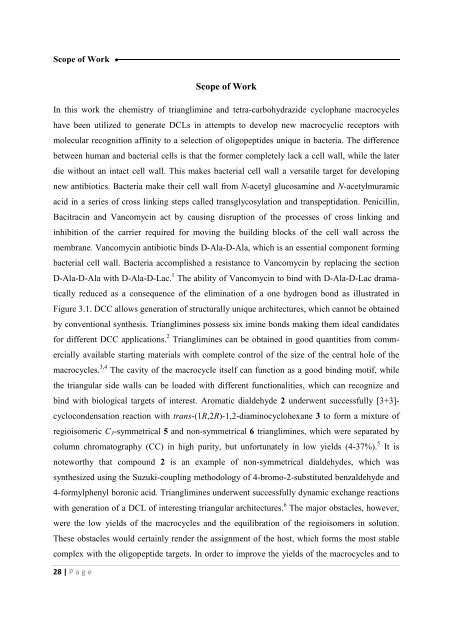The Development of Novel Antibiotics Using ... - Jacobs University
The Development of Novel Antibiotics Using ... - Jacobs University
The Development of Novel Antibiotics Using ... - Jacobs University
You also want an ePaper? Increase the reach of your titles
YUMPU automatically turns print PDFs into web optimized ePapers that Google loves.
Scope <strong>of</strong> Work<br />
Scope <strong>of</strong> Work<br />
In this work the chemistry <strong>of</strong> trianglimine and tetra-carbohydrazide cyclophane macrocycles<br />
have been utilized to generate DCLs in attempts to develop new macrocyclic receptors with<br />
molecular recognition affinity to a selection <strong>of</strong> oligopeptides unique in bacteria. <strong>The</strong> difference<br />
between human and bacterial cells is that the former completely lack a cell wall, while the later<br />
die without an intact cell wall. This makes bacterial cell wall a versatile target for developing<br />
new antibiotics. Bacteria make their cell wall from N-acetyl glucosamine and N-acetylmuramic<br />
acid in a series <strong>of</strong> cross linking steps called transglycosylation and transpeptidation. Penicillin,<br />
Bacitracin and Vancomycin act by causing disruption <strong>of</strong> the processes <strong>of</strong> cross linking and<br />
inhibition <strong>of</strong> the carrier required for moving the building blocks <strong>of</strong> the cell wall across the<br />
membrane. Vancomycin antibiotic binds D-Ala-D-Ala, which is an essential component forming<br />
bacterial cell wall. Bacteria accomplished a resistance to Vancomycin by replacing the section<br />
D-Ala-D-Ala with D-Ala-D-Lac. 1 <strong>The</strong> ability <strong>of</strong> Vancomycin to bind with D-Ala-D-Lac dramatically<br />
reduced as a consequence <strong>of</strong> the elimination <strong>of</strong> a one hydrogen bond as illustrated in<br />
Figure 3.1. DCC allows generation <strong>of</strong> structurally unique architectures, which cannot be obtained<br />
by conventional synthesis. Trianglimines possess six imine bonds making them ideal candidates<br />
for different DCC applications. 2 Trianglimines can be obtained in good quantities from commercially<br />
available starting materials with complete control <strong>of</strong> the size <strong>of</strong> the central hole <strong>of</strong> the<br />
macrocycles. 3,4 <strong>The</strong> cavity <strong>of</strong> the macrocycle itself can function as a good binding motif, while<br />
the triangular side walls can be loaded with different functionalities, which can recognize and<br />
bind with biological targets <strong>of</strong> interest. Aromatic dialdehyde 2 underwent successfully [3+3]-<br />
cyclocondensation reaction with trans-(1R,2R)-1,2-diaminocyclohexane 3 to form a mixture <strong>of</strong><br />
regioisomeric C 3 -symmetrical 5 and non-symmetrical 6 trianglimines, which were separated by<br />
column chromatography (CC) in high purity, but unfortunately in low yields (4-37%). 5 It is<br />
noteworthy that compound 2 is an example <strong>of</strong> non-symmetrical dialdehydes, which was<br />
synthesized using the Suzuki-coupling methodology <strong>of</strong> 4-bromo-2-substituted benzaldehyde and<br />
4-formylphenyl boronic acid. Trianglimines underwent successfully dynamic exchange reactions<br />
with generation <strong>of</strong> a DCL <strong>of</strong> interesting triangular architectures. 6 <strong>The</strong> major obstacles, however,<br />
were the low yields <strong>of</strong> the macrocycles and the equilibration <strong>of</strong> the regioisomers in solution.<br />
<strong>The</strong>se obstacles would certainly render the assignment <strong>of</strong> the host, which forms the most stable<br />
complex with the oligopeptide targets. In order to improve the yields <strong>of</strong> the macrocycles and to<br />
28 | P a g e

















